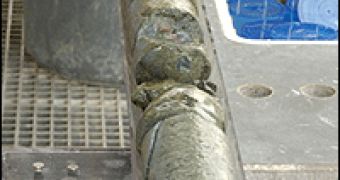The Earth's crust even in places where it's thinnest, at the bottom of the Pacific Ocean, is more than 6 km thick. Nonetheless scientists have tried to drill through it since 1950s in an attempt to reveal the mantle beneath. That goal is far from being reached even today.
However, a new American-Japanese drilling project at the bottom of the Pacific, 800 kilometers west of Costa Rica, managed to reach about one and a half kilometers below the surface. They haven't exposed the mantle but did expose what lies beneath the uppermost layer of crust. This is a record drill.
Scientists started to drill in this area in 2002 because they knew that more than 12 million years ago this region of the Pacific had formed the new crust at record rates, faster than any spreading occurring today. This means that the volcanic rock, called gabbro, that forms beneath the uppermost layer of the crust should be here near the sea-floor. "If that theory were to be correct then we should only need to drill a relatively shallow hole compared to anywhere else," explained team member Doug Wilson, a geophysicist at the University of California, Santa Barbara.
And indeed, after five months of drilling, at around 1,200 meters below the ocean floor, the drill bit penetrated the overlying crust rock and reached gabbros. This is the first time scientists have ever recovered gabbros intact from the depths of the ocean's basement. They hope that this would help better understand how the crust is formed.
"Having this sample from the deep fossil magma allows us to compare its composition to the overlying lavas," says team member Jeffrey Alt of the University of Michigan. "It will help explain whether ocean crust, which is about six to seven kilometers thick, is formed from one high-level magma chamber or from a series of stacked magma lenses."
The scientists intend to drill even deeper at the same site, uncovering more information about crust formation.
Photo credit: IODP/TAMU

 14 DAY TRIAL //
14 DAY TRIAL //